
The noted blogger Fjordman is filing this report via Gates of Vienna.
For a complete Fjordman blogography, see The Fjordman Files. There is also a multi-index listing here.

I had a conversation recently with a good friend of mine regarding the situation in Western Europe, with rapidly rising ethnic and religious tensions caused by mass immigration. Historically, the usual situation is that Muslims keep the lands they have taken possession of. There are a few exceptions, for instance with the Reconquista in the Iberian Peninsula, but this took centuries. If this pattern still holds up, the situation does admittedly look bleak.
The problem is that the circumstances this time around are very special. We are dealing with the unprecedented situation where a militarily inferior group is allowed by the authorities in technologically stronger countries to settle in their lands and harass the local population. Muslims haven’t actually defeated us in warfare. Do the old rules then apply? Nobody knows for certain. It is difficult to predict the future, apart from the fact that there will be a lot of turbulence here in the coming years and decades.
 In my book Defeating Eurabia I quoted the American scholar Daniel Pipes, who believes that the decisive events in Europe have yet to take place, perhaps within the next decade or so. As Pipes puts it, the situation is historically unprecedented: “No large territory has ever shifted from one civilization to another by virtue of a collapsed population, faith, and identity; nor has a people risen on so grand a scale to reclaim its patrimony. The novelty and magnitude of Europe’s predicament make it difficult to understand, tempting to overlook, and nearly impossible to predict. Europe marches us all into terra incognita.”
In my book Defeating Eurabia I quoted the American scholar Daniel Pipes, who believes that the decisive events in Europe have yet to take place, perhaps within the next decade or so. As Pipes puts it, the situation is historically unprecedented: “No large territory has ever shifted from one civilization to another by virtue of a collapsed population, faith, and identity; nor has a people risen on so grand a scale to reclaim its patrimony. The novelty and magnitude of Europe’s predicament make it difficult to understand, tempting to overlook, and nearly impossible to predict. Europe marches us all into terra incognita.”I write about European history in order to gain inspiration from our past so that we can face the future with self-confidence. While reading about our artistic and scientific contributions to world culture is inspiring, we should not leave out our military traditions. They, too, constitute a part of our heritage, and we may soon need to revive some of those traditions. In The Cambridge History of Warfare, Geoffrey Parker states that the Western way of war boasts great antiquity and great continuity, with emphasis on technology and organization:
“First, the armed forces of the West have always placed heavy reliance on superior technology, usually to compensate for inferior numbers. That is not to say that the West enjoyed universal technological superiority — until the advent of musketry volleys and field artillery in the early seventeenth century, the recurved bow used by horse archers all over Asia proved far more effective than any western weaponry — but, with few exceptions, the horse archers of Asia did not directly threaten the West and, when they did, the threat was not sustained. Nor did all the advanced technology originate in the West: many vital innovations, including the stirrup and gunpowder, came from eastern adversaries. Normally, military technology is the first to be borrowed by every society, because the penalty for failing to do so can be immediate and fatal; but the West seems to have been preternaturally receptive to new technology, whether from its own inventors or from outside. Technological innovation, and the equally vital ability to respond to it, soon became an established feature of western warfare.”
An effective pre-modern use of chemical innovations in warfare was the flammable substance known as “Greek fire,” which was employed by the Christians of the Eastern Roman/Byzantine Empire in the seventh century to set ablaze the attacking Muslim fleet. The Byzantines lost important provinces to Muslims, but managed to salvage Constantinople and thus ensure the survival of a diminished version of their Empire for many centuries to come.
According to historian Raymond Ibrahim, the author of the book The Al Qaeda Reader , “Though many historians have rightly hailed the somewhat contemporary Battle of Tours of 732, where Charles the Hammer repulsed the invading Muslim armies, as one of the most decisive victories for Western civilization, in fact, the Byzantine victory over the Muslims is more important: it had the full backing of the caliphate, and consisted of far greater manpower. Had the Muslims won, and since Byzantium was the bulwark of Europe’s eastern flank, there would have been nothing in their way from turning the whole of Europe into the north-western appendage of Dar al-Islam.”
One of the greatest revolutions in the history of warfare began with the Chinese invention of gunpowder. The Mongol conquests spread the knowledge of gunpowder across Eurasia in the thirteenth century, although it is possible that some information regarding the invention had followed normal trade routes before this. The Mongols never reached Western Europe, yet they did a brief, but damaging invasion of Eastern Europe and had a lasting impacting on Ukrainian and Russian history after the destruction of the great city of Kiev.
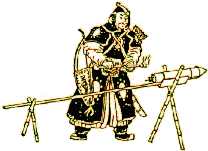 According to Arnold Pacey in Technology in World Civilization: A Thousand-Year History, “Four years after the invasion of 1241, the pope sent an ambassador to the Great Khan’s capital in Mongolia. Other travellers followed later, of whom the most interesting was William of Rubruck (or Ruysbroek). He returned in 1257, and in the following year there are reports of experiments with gunpowder and rockets at Cologne. Then a friend of William of Rubruck, Roger Bacon, gave the first account of gunpowder and its use in fireworks to be written in Europe. A form of gunpowder had been known in China since before AD 900, and as mentioned earlier, in 1040 some recipes for gunpowder mixtures appeared in a printed book. One mixture was for making incendiary weapons and another gave a mild explosive. Rockets were invented in China before 1150, and a gunpowder formula which produced violent explosions was known a century later. Much of this knowledge had reached the Islamic countries by then, and the saltpetre used in making gunpowder there was sometimes referred to, significantly, as ‘Chinese snow’. The Mongols did not have gunpowder weapons in Hungary in 1241, but acquired them from the Chinese soon after.”
According to Arnold Pacey in Technology in World Civilization: A Thousand-Year History, “Four years after the invasion of 1241, the pope sent an ambassador to the Great Khan’s capital in Mongolia. Other travellers followed later, of whom the most interesting was William of Rubruck (or Ruysbroek). He returned in 1257, and in the following year there are reports of experiments with gunpowder and rockets at Cologne. Then a friend of William of Rubruck, Roger Bacon, gave the first account of gunpowder and its use in fireworks to be written in Europe. A form of gunpowder had been known in China since before AD 900, and as mentioned earlier, in 1040 some recipes for gunpowder mixtures appeared in a printed book. One mixture was for making incendiary weapons and another gave a mild explosive. Rockets were invented in China before 1150, and a gunpowder formula which produced violent explosions was known a century later. Much of this knowledge had reached the Islamic countries by then, and the saltpetre used in making gunpowder there was sometimes referred to, significantly, as ‘Chinese snow’. The Mongols did not have gunpowder weapons in Hungary in 1241, but acquired them from the Chinese soon after.”- - - - - - - - -
Gunpowder (black powder) consists of charcoal, sulphur and potassium nitrate, or saltpeter, and was impossible to create until you could manufacture saltpeter with some degree of purity. This was a specialty of Chinese alchemists quite early. Gunpowder was definitely known in China by the eleventh century and probably some generations prior to this, possibly before AD 900. The English theologian and scholar Roger Bacon and the German friar and scholar Albertus Magnus, also known as Albert the Great or Albert of Cologne, both mentioned a recipe for gunpowder in the late thirteenth century. Black powder remained the principle explosive until the Swedish inventor Alfred Nobel patented dynamite in 1867.
While the first crude handguns and weapons employing gunpowder were invented by the Chinese themselves, it appears that Europeans were the first to invent large cannons, in the decades before and after the year 1300. By 1500 the manufacture of guns had become a universal technology among all major Eurasian civilizations. Arnold Pacey writes:
“Bronze barrels for cannon were being produced in such quantity and in so many countries by about 1500 that one historian has called this a ‘second bronze age’. Not only was there large-scale production in Europe, the Ottoman Empire, India and China, but before 1650 guns had been manufactured in Korea, Japan, Siam and Iran, and occasionally in many other places, notably Benin, the famous West African bronze-casting centre. Since bronze was an alloy of copper with small amounts of tin, the mining of these metals expanded greatly. Copper was exported by Japan in the east and Sweden in the west, and tin mining developed fast in Malaya. All this can be traced back to the small hand-guns made in China before 1288, which stimulated the development of large cannon, first in Europe (before 1320), then in the Islamic world (1330s) and in China itself (1356). Beyond this, the acquisition of guns by Korea during the 1370s is of interest as a well-documented transfer of technology from China….No other countries are known to have obtained gun-making technology from China, where methods and designs were both conservative and protected by secrecy, but many nations obtained guns…through contact with the Portuguese.”
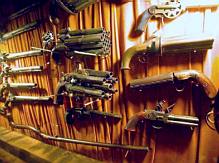 Interestingly enough, firearms reached Japan in the mid-sixteenth century with Portuguese adventurers who came from the other side of the world, not from neighboring China. While the Chinese were the first to use gunpowder in warfare, the most dynamic development of such weapons took place in Europe. A Jesuit mission in Beijing provided gun-making expertise to the natives during the downfall of the Ming Dynasty in the 1640s.
Interestingly enough, firearms reached Japan in the mid-sixteenth century with Portuguese adventurers who came from the other side of the world, not from neighboring China. While the Chinese were the first to use gunpowder in warfare, the most dynamic development of such weapons took place in Europe. A Jesuit mission in Beijing provided gun-making expertise to the natives during the downfall of the Ming Dynasty in the 1640s.According to Harry G. Gelber in The Dragon and the Foreign Devils: China and the World, 1100 B.C. to the Present, “gunpowder had long since been a Chinese invention, but the Ming showed comparatively little interest in its military applications. After all, using crossbows from behind walls was quite effective against nomad cavalry. The Mongols had already used cannon in their sieges and even the Ming had some early muskets and bombs, but it was not until the Japanese invaders of Korea had used cannon successfully in the 1590s that the Chinese condescended to learn much about them. In 1621, when the Portuguese offered four cannon to the emperor, they found they had to send cannoneers with them. The following year the court asked Jesuits from Macao to cast cannon for China and twenty years later another of them, Adam Schall himself, was asked to cast more and teach the Chinese how to make them. In fact, some of the old Jesuit cannon were still being used in the nineteenth century.”
At the outset of the Hundred Years’ War (1337-1453), the primary means of combat remained the longbow, the crossbow, the pike and the armored knight mounted on an armored charger. At the end, gunpowder artillery won out. Joan of Arc (1412-31), an illiterate peasant girl, could be militarily useful during this transitional period with new technology. She became a national symbol for France, which emerged as a strong entity in fifteenth century.
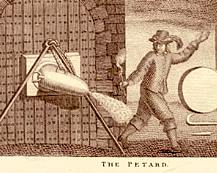 The “gunpowder revolution” facilitated the rise of large, expensive armies and centralized states. The new weaponry rendered medieval castles and city walls obsolete. Because of the cost of keeping abreast of changing technology and of maintaining the resources to deploy it effectively, relatively few states proved able to remain in the race. Some, like Denmark, proved too small, while others, like Poland after 1667, too fragmented. James E. McClellan and Harold Dorn write in Science and Technology in World History , second edition:
The “gunpowder revolution” facilitated the rise of large, expensive armies and centralized states. The new weaponry rendered medieval castles and city walls obsolete. Because of the cost of keeping abreast of changing technology and of maintaining the resources to deploy it effectively, relatively few states proved able to remain in the race. Some, like Denmark, proved too small, while others, like Poland after 1667, too fragmented. James E. McClellan and Harold Dorn write in Science and Technology in World History , second edition:“The musket was introduced in the 1550s, and in their reforms Maurice and William Louis of Nassau instituted volley fire by extended rows of musketeers using standardized muskets and coordinated routines of loading and firing. Those reforms and standardized field artillery made for potent new armies from 1600. In the face of muskets and artillery, longbows, crossbows, broadswords, cavalry, and pikemen exercised diminished roles or vanished entirely from the scene of the battle. Infantry, now bristling with handguns, once again became a dominant arm on the field of battle. As a result, over the next two centuries the size of standing armies of several European states jumped dramatically from the range of 10,000 to 100,000 soldiers. During the last 70 years of the seventeenth century alone the French army grew from 150,000 to perhaps 400,000 under the Sun King, Louis XIV.”
In addition to technology, Western military practice has generally exalted discipline in the form of drill and long-term service. It is wrong to assume that Europeans during their first contact with Asians in the early modern era were always technologically superior. Indians had made fine guns from brass since the sixteenth century. Europeans at the time did not have good methods for smelting zinc, which was done extensively in India and China. Brass was made in large quantities in Britain and Germany by the mid-eighteenth century. It is not clear whether this was based on imported Asian techniques, but this remains plausible.
According to Pacey, “Britain’s ‘conquest’ of India cannot be attributed to superior armaments. Indian armies were also well equipped. More significant was the prior breakdown of Mughal government and the collaboration of many Indians. Some victories were also the result of good discipline and bold strategy, especially when Arthur Wellesley, the future Duke of Wellington, was in command. Wellesley’s contribution also illustrates the distinctive western approach to the organizational aspect of technology. Indian armies might have good armament, but because their guns were made in a great variety of different sizes, precise weapons drill was impossible and the supply of shot to the battlefield was unnecessarily complicated. By contrast, Wellesley’s forces standardized on just three sizes of field gun, and the commander himself paid close attention to the design of gun carriages and to the bullocks which hauled them, so that his artillery could move as fast as his infantry, and without delays due to wheel breakages. Significantly, the one major criticism regularly made of Indian artillery concerned the poor design of gun carriages. Many, particularly before 1760, were little better than four-wheeled trolleys. But the guns themselves were often of excellent design and workmanship.”
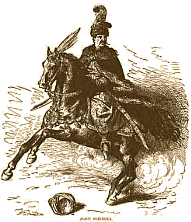 Ironically, Westerners have often performed at our best when we have been the underdogs. As Geoffrey Parker states, “Once again, the crucial advantage lay in the ability to compensate for numerical inferiority, for whether defending Europe from invasion (as at Plataea in 479 BC, at the Lechfeld in AD 955 and at Vienna in AD 1683), or in subduing the Aztec, Inca and Mughal empires, the western forces have always been outnumbered by at least two to one and often by far more. Without superb discipline as well as advanced technology, these odds would have proved overwhelming. Even Alexander the Great and his 60,000 Greek and Macedonian troops could scarcely have destroyed the forces of the Persian empire in the fourth century BC without superior discipline, since his adversaries probably numbered more Greek soldiers (fighting with much the same equipment) in their own armies!”
Ironically, Westerners have often performed at our best when we have been the underdogs. As Geoffrey Parker states, “Once again, the crucial advantage lay in the ability to compensate for numerical inferiority, for whether defending Europe from invasion (as at Plataea in 479 BC, at the Lechfeld in AD 955 and at Vienna in AD 1683), or in subduing the Aztec, Inca and Mughal empires, the western forces have always been outnumbered by at least two to one and often by far more. Without superb discipline as well as advanced technology, these odds would have proved overwhelming. Even Alexander the Great and his 60,000 Greek and Macedonian troops could scarcely have destroyed the forces of the Persian empire in the fourth century BC without superior discipline, since his adversaries probably numbered more Greek soldiers (fighting with much the same equipment) in their own armies!”Moreover, “This military edge meant that the West seldom suffered successful invasion itself. Armies from Asia and Africa rarely marched into Europe and many of the exceptions — Xerxes, Hannibal, Attila, the Arabs and the Turks — achieved only limited success. None encompassed the total destruction of their foe. Conversely, western forces, although numerically inferior, not only defeated the Persian and Carthaginian invaders but managed to extirpate the states that sent them. Even the forces of Islam never succeeded in partitioning Europe into ‘spheres of influence’ in the western manner. On the other hand, however, time and again a favourable balance of military power critically advanced western expansion.”
We must look at the theory of European warfare, too. The overall aim of Western strategy usually remained the total defeat and destruction of the enemy, and this contrasted starkly with the military practice of many other societies. The German (Prussian) general and military thinker Carl von Clausewitz (1780-1831) gained practical experience during the Napoleonic wars. His great work Vom Kriege (On War) was published posthumously by his wife in 1832 and is still studied carefully at military academies around the world. However, Clausewitz’s work is deeply tied to the modern state structure. It is not clear whether all his theories will be applicable in the case of civil wars and ethnic warfare within failing nation states, which we may unfortunately face in the twenty-first century in a number of Western countries due to ethnic tensions caused by runaway mass immigration from alien cultures.
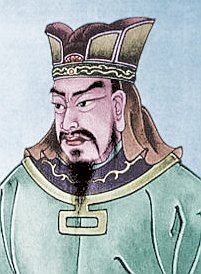 Arguably the greatest treatise on war ever written in any nation or age is The Art of War, traditionally ascribed to the Chinese military strategist Sun Tzu or Sunzi. Scholars who believe that he was an historical person (a view which is disputed by some non-traditionalists) often place him early in the Warring States Period (476-221 BC), perhaps in the fifth century BC. Whether he is an historical person or not, The Art of War is undoubtedly very old, yet has remained surprisingly fresh to this day with its advice on information gathering regarding the enemy’s troops and dispositions and its emphasis on flexibility, deceit and psychological warfare. According to Sun Tzu, “Seizing the enemy without fighting is the most skillful.”
Arguably the greatest treatise on war ever written in any nation or age is The Art of War, traditionally ascribed to the Chinese military strategist Sun Tzu or Sunzi. Scholars who believe that he was an historical person (a view which is disputed by some non-traditionalists) often place him early in the Warring States Period (476-221 BC), perhaps in the fifth century BC. Whether he is an historical person or not, The Art of War is undoubtedly very old, yet has remained surprisingly fresh to this day with its advice on information gathering regarding the enemy’s troops and dispositions and its emphasis on flexibility, deceit and psychological warfare. According to Sun Tzu, “Seizing the enemy without fighting is the most skillful.”Other military cultures such as those of East Asia also placed a high premium on technology and discipline. However, the West differed in its unique ability to change and conserve its military practices as need arose and in its power to finance those changes. Underlying the strength of their militaries has been the strength of Western economies. Geoffrey Parker:
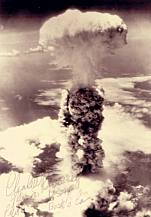 “Harlech castle, one of Edward I’s magnificent fortifications in Wales, cost almost an entire year’s revenue to build, but in 1294 its garrison of only thirty-seven soldiers successfully defended it against attack. The king’s strategic vision anticipated that of the ‘Manhattan Project’, which spent millions of dollars on the production of nuclear devices which, delivered on two August mornings in 1945 by just two airplanes, precipitated the unconditional surrender of Imperial Japan and the millions of her troops still in arms all over southeast Asia. After the introduction of gunpowder weapons and defences, the cost…of military hardware rose to such a degree that only a centralized state could afford to buy….Naturally, the less developed the economy, the less easily the cost of military preparedness could be absorbed — even within the West. Thus in 1904, France spent 36 per cent of her budget on the army whereas Germany spent only 20 per cent; however, in real terms this meant that France spent only thirty-eight million francs as against ninety-nine million by Germany. Thus France devoted twice as much of her budget in order to spend only half as much as her major rival.”
“Harlech castle, one of Edward I’s magnificent fortifications in Wales, cost almost an entire year’s revenue to build, but in 1294 its garrison of only thirty-seven soldiers successfully defended it against attack. The king’s strategic vision anticipated that of the ‘Manhattan Project’, which spent millions of dollars on the production of nuclear devices which, delivered on two August mornings in 1945 by just two airplanes, precipitated the unconditional surrender of Imperial Japan and the millions of her troops still in arms all over southeast Asia. After the introduction of gunpowder weapons and defences, the cost…of military hardware rose to such a degree that only a centralized state could afford to buy….Naturally, the less developed the economy, the less easily the cost of military preparedness could be absorbed — even within the West. Thus in 1904, France spent 36 per cent of her budget on the army whereas Germany spent only 20 per cent; however, in real terms this meant that France spent only thirty-eight million francs as against ninety-nine million by Germany. Thus France devoted twice as much of her budget in order to spend only half as much as her major rival.”Another key feature of the Western tradition is a remarkable continuity in military theory, and in this as well as in science and technology North America is very much an extension of the European tradition. By the twentieth and early twenty-first centuries, the USA was the greatest military-technological power in the world, but already in the nineteenth century Americans made contributions, for instance the popular revolver invented by Samuel Colt (1814-1862) or the successful machine gun invented by Richard Jordan Gatling (1818-1903).
George Washington (1732-1799), the first President of the United States of America, possessed his own copy of De Re Militari (Concerning Military Matters), a compendium of Roman military practice first composed by Flavius Renatus Vegetius around the year AD 390 and revised into its final form about fifty years later. It remained popular and studied throughout the medieval and modern era. The same can be said about other classical works on military affairs. In The Cambridge History of Warfare, Geoffrey Parker writes:
“In AD 1594 Maurice of Nassau and his cousins in the Netherlands devised the crucial innovation of volley fire for muskets after reading the account in Aelian’s Tactics (written c. AD 100) of the techniques employed by the javelin- and sling-shot throwers of the Roman army, and spent the next decade introducing to their troops the drills practised by the legions. In the nineteenth century Napoleon III and Helmut von Moltke both translated the campaign histories of Julius Caesar, written almost 2,000 years earlier, while Count Alfred von Schlieffen and his successors in the Prussian general staff expressly modelled their strategy for destroying France in the ‘next war’ upon the stunningly successful tactic of encirclement attributed by Roman writers to Hannibal at the battle of Cannae in 216 BC….General George C. Marshall argued that a soldier should begin his military education by reading Thucydides’ History of the Peloponnesian War, written almost 2,500 years before. These striking continuities derive from the fact that ancient theorists and modern practitioners of war shared not only a love of precedent, and a conviction that past examples could and should influence present practice, but also a willingness to accept ideas from all quarters.”
Hannibal (247-ca. 183 BC) from the North African city of Carthage with its Phoenician-derived culture is generally considered one of the greatest military leaders of Antiquity. He was feared by contemporary Romans and commanded the Carthaginian forces with great skill in the Second Punic War (218-201 BC). The Italian Renaissance writer, civil servant and political theorist Niccolò Machiavelli (1469-1527), known for his works Discourses on Livy and especially The Prince, admired Hannibal as a military commander but was otherwise heavily influenced by Roman examples. His “Machiavellian” view of politics as a practical discipline, based on empirical studies, is far removed from Greek idealism.
The Punic Wars illustrate how ruthless the Romans could be in dealing with potential threats. The statesman and orator Marcus Porcius Cato (234-149 BC), better known as Cato the Elder, famously repeated the mantra Carthago delenda est, “Carthage must be destroyed,” as often as he could. Carthage was destroyed during the Third Punic War (149-146 BC). After this, Rome’s position as the greatest political force in the Mediterranean world was uncontested.
Many bad things can be said about the Romans, who had numerous flaws. However, the one flaw that they didn’t have was self-loathing. How would the ancient Romans in the mature phase of their civilization have reacted to the threat posed by Islamic Jihad? I seriously doubt that they would have blamed themselves for being attacked, as many modern Westerners did after the terrorist attacks of 9/11 or the London and Madrid bombings. I also doubt whether they would have reacted with similar passivity faced with the repeated gang rapes of their daughters by hostile aliens in their cities. My bet is that faced with such Jihadist attacks, a prominent member of the Roman Senate would now have been saying Mecca delenda est.

16 comments:
Wonderful article Fjordman but a history of Western warfare is incomplete without reference to Victor Davis Hanson's "Carnage and Culture: Landmark Battles in the Rise of Western Power".
I am currently halfway through this book and Dr. Hanson's thesis is that it is democracy and freedom that makes the Western way of war more fierce and destructive than all others. He posits that we freely fight to protect that which is ours while our enemies have historically been made up of armies of conscripts and slaves who fight only out of fear of punishment. His account of the Greeks' defeat of the Persians at Salamis is riveting and quite satisfying.
A pleasure, as always, to read your essays, Fjordman! The evidence of the cultural superiority of the West is ubiquitous and overwhelming. Which makes our political elites who so love the greasy Third World all the more pathetic. And treasonous.
Just to add a bit to the discussion,
let me point out that to modern gun collectors and students of arms, Japanese firearms exhibit a very distinctive local style. They are typically single shot muzzleloading matchlocks ( that is, the ignition source is a length of "slowmatch" - rope soaked in saltpeter which smolders slowly when lit ) which are fitted with very characteristic "snapping" locks. The lock has an arm which holds the smoldering slowmatch and snaps forward when the trigger is pulled, the burning tip of the slowmatch is swung down into the priming pan, thus igniting the charge.
The odd thing about this is that this design remained in use virtually UNCHANGED from the time of its introduction by the Portuguese until the mid 1800's,
roughly 300 years! Meanwhile, in the West, wheellocks, snaphance locks, flintlocks, percussion ignition, and metallic cartridges were developed.
Once again, we see the startling contrast between the West and other societies. INNOVATION seems to be a fundamental Western dynamic.
Wonderful.
We are dealing with the unprecedented situation where a militarily inferior group is allowed by the authorities in technologically stronger countries to settle in their lands and harass the local population.
By no fault of its own, this succinctly accurate summation barely manages to convey the depth of treason involved. It is the equivalent of putting a scanning electron microscope into the hands of illiterate nomadic savages.
"... Normally, military technology is the first to be borrowed by every society, because the penalty for failing to do so can be immediate and fatal; but the West seems to have been preternaturally receptive to new technology, whether from its own inventors or from outside. Technological innovation, and the equally vital ability to respond to it, soon became an established feature of western warfare.”
This Cambridge passage offers up a glimpse of the important point that Charlemagne alludes to as well when he notes how prevailing Western armies were typically composed of free people opposing forcefully conscripted victims of tyrannous regimes.
None of this addresses a central and vital difference in modern Western military doctrine. And that is of the independently thinking soldier.
An apt comparison would be between Soviet and Nato forces. Communist Russian soldiers were not issued maps for fear that they would use them to defect. Moreover, even the cartography provided to higher ranking officers was intentionally altered to mislead or conceal the actual locations of strategic sites.
Books like "The Third World War", by ex-NATO general Sir John Hackett and other contemperaneous works all routinely predicted air-to-air combat kill ratios on the order of 20:1 while ground-based conflicts usually relected even more disproportionate outcomes. One reason for this was that communist military doctrine centralized and concentrated it C3 (Command, Control & Communication) structure. This made decapitating strikes far more effective than they otherwise might be.
In contrast, Western troops trained under an ethos that soldiers should operate relatively independently with some degree of latitude in refusing blatantly inept or criminal orders. No such discernment was allowed the majority of our foes at that time.
Therefore, it is not just that, as Charlemagne cites via Dr. Hansen, "we freely fight to protect that which is ours", but that we do so in a free-thinking manner.
Concomitant with that free thought is the concept of private property that gives us something to fight for along with the other freedoms of speech, religion and legal rights that makes them worth fighting for.
All of the foregoing freedoms represent the very fountainhead of innovation that has driven the puissance of Western militaries. However, I still maintain that it is this free-thinking aspect of Western, and especially American troops, that makes them so invincible on the battlefield.
I do think it's rather evident what Rome would have done against islamic jihad : they would have conquered the oil fields, then used the money they got from it to get muslim countries to fight eachother, each time providing superior weaponry to the weakest party, allowing it to commit a massacre on the stronger foe.
Unfortunately, as everybody knows, this tactic was defeated. Mostly due to too thinly spread forces around critical infrastructure and recruitment problems. Also a failure to protect "the Roman street", similar to our current problems, although not fatal to the Roman empire, nevertheless managed to land very significant blows to it.
Another terrific article by the one and only Fjordman. If only more Europeans (and Americans) were exposed to his writings people would not only grasp the value and acomplishments of European culture they would have the pride in it to defend it. As long as Europeans and Americans keep buying into the multicultural myths that portray Western Civilization as evil or simply no better than ay other, the colonization will continue.
Keep it Fjordman.
Predator drones and Hellfire missiles are changing the entire formula for warfare, particularly Islamic jihad. The command center for the drones is a continent away. They are not targeting the front lines but rather those directing the jihad from the rear. And it is suspected that somehow the vectoring is accomplished by tracking cell
Hey Fjordman, nice mask of your genocidal intentions by putting the words "Mecca delenda est" into the framework of a "modern day Cato."
Dar Al Islam has already made it clear that this is going to be a contest to the death ... that Islam will not stop the violence until we all submit.
The proper response to an attempt at enslavement is to annihilate the wannabe slave master.
This is not genocide ... Dar Al Islam can end this at any time, by simply not continuing this war. If they stop attacking us, our troops will all withdraw, and we will stop killing them.
If they choose to continue, then "Mecca Delenda Est" will eventually happen.
Too bad Mo wasn't born 6-800 years earlier. If so the history of islam would have been the thinnest book in known history.
Too bad Mo wasn't born 6-800 years earlier. If so the history of islam would have been the thinnest book in known history.
Gordon, the only people advocating Genocide are Muslims, who remain convinced that A. The Holocaust never happened, and B. It must be "finished right this time."
See Iran's constant threat to wipe Israel off the map. A distant, tiny state which is no concern whatsoever to Iranians, save the rabid hatred nearly all Muslims have for Jews, as a result of their debased social structure of polygamy.
My criticism of Fjordman is that he avoids the central issue.
Technology has changed, in fact become a cheap commodity. No longer do Western forces have an advantage, in many ways they face foes better armed than themselves, and with superior discipline. Even more important, significant portions of Western Peoples hope and pray for defeat.
The AK-47 is at least as good, if not better, a battle weapon as the M-16, considerably cheaper and more reliable, and well supplied to the non-Western Jihadist enemies. The IED can defeat even the mighty main battle tanks of the West, and of course night vision goggles, extensive training in camps, and proliferation of communications gear as in Bombay makes enemy Jihadists every bit as disciplined and effective as Western regular forces.
Then there are nukes. EVEN failing states and peoples like North Korea, Iran, and Pakistan have them or are very close to getting them. Soon Saudi Arabia, most of the Gulf, Egypt, Syria, Turkey, and many other nations will have them too. Along with ICBMs and stealth delivery systems of deniable terrorist proxies.
This then gives various groups, if they can but get ahold of a nuke, borrow it, steal it, beg for it, threaten for it, or bribe for it ... the ability to destroy at an instant, undetectable and undeterred, a major Western City and about Six Million People.
Oh contrary, to the PC fantasies of Gordon, the situation is deadly. Because Western forces have nukes too.
ONCE they get used, on a Western City, they will be used again. And all Gordon's status-mongering, PC Dogma, multiculturalism, and other moralizing will disappear as frightened, angry, survival mode people decide THEY WANT TO LIVE. And will do anything to live.
Which means in effect wiping out all nuclear weapons ... and the people who made them, from Muslim countries. This is Wretchard's Third Conjecture.
People like myself get angry with you Gordon, and Obama, and the other idiots, because we see the oncoming trainwreck of terrorist nukes in places like Pakistan or Iran, factionalized, a bunch of tribes with a flag and certain that killing lots of Americans will bring in wealth, power, prestige, just like all the other times. Viewing Nukes as a giant car bomb.
Reasonable, limited, merciful, and deterring actions are forbidden, because of maudlin PC nonsense about who is morally superior (Obama and his loony followers are the worst offenders in that regard, among the many contenders).
Eventually leading to just such a nuking of a Western City. Which in the end means pure survival mode: kill the enemy before you are killed.
What Fjordman left unsaid is the fact that peoples who stone adulterers and hang women for being raped, now have nukes. Illiterate, tribal, beset by eternal violence that stems from polygamy and distrust. Peoples who would be by any other name a failure. Yet they can kill NYC and everyone in it.
Betting on PC to hold back Western nuclear forces from an overwhelming counter-response in such an event is stupid.
Whiskey, you are not up-to-date with your comments regarding AK-47 vs M-16.
In the early days of the Vietnam war, you would have been right. Early M-16 designs were faulty and unreliable. Since that time, the US army spent a lot of effort and money to improve the weapon. Current M-16 is much more reliable than the early designs.
AK-47 is a simple weapon for untrained, perhaps illiterate conscript troops in third-world settings. This simplicity comes at a cost. The weapon is seriously inaccurate (basically "spray and pray" firing tactics) and lacks any sophisticated equipment like mountable night vision. In the Iraq counterinsurgency, a lot of the fighting was done in the night. Ask the (dead) insurgents how well they fared with AK-47 there.
Not even the more advanced Communist armies would use AK-47s. The Czechoslovak People Army, even during the yoke of Moscow, used its own design, SA-58.
As for the IEDs: yes, an IED can destroy a tank, but it usually does not. First, timing: you need to be very precise to detonate the IED at the right time; and most of the IED operators do not learn this skill in their short lifetimes. Second, the efficiency of the IED depends a lot on its design. The most efficient IEDs, EFPs (Explosively Formed Penetrators) are factory made, and cannot be improvised in a garage.
Finally, you seem to underestimate the greatest military development of the last decade: unmanned aerial vehicles. In combination with good firepower, they are absolutely deadly.
To Marian about AK-47, that inaccuracy is broad generalisation. There are many ak-47 variants in use. Some are quite inaccurate, like chinese built Norincos, and some are quite accurate, like Finnish RK-series, and Bulgarian SAR-series, Israeli Galils.
Also ability to use sophisticated equipment varies, some AK's can be mounted with them, some cannot.
AK-47 is quite broad subject, and they vary quite much depending on model and manufacturer. What is one common feature in them though is legendary reliability, which is mainly due to overpowered gas-system. AK has quite much reserve power for cycling its action, which prevents malfuntion due to unclean weapon or sand etc.. It has though some repercussions, mainly increased recoil compared to m-16 series, and wrecked cartridge cases (though they are concern only for civilian reloaders).
In general, high quality ak47's or high quality weapons based on ak-47 can be accurate weapons, and can hit human head sized targets from 300 meters consistently on single fire, if shooter is competent enough. Inaccuracy is mainly due to poor training and/or cheap low quality weapons.
Excellent post, Whiskey. Keep up the good work.
Islam delenda est
Post a Comment